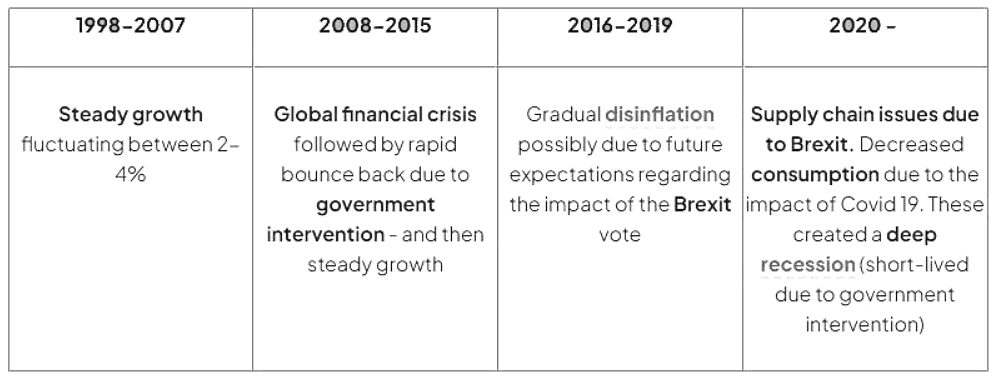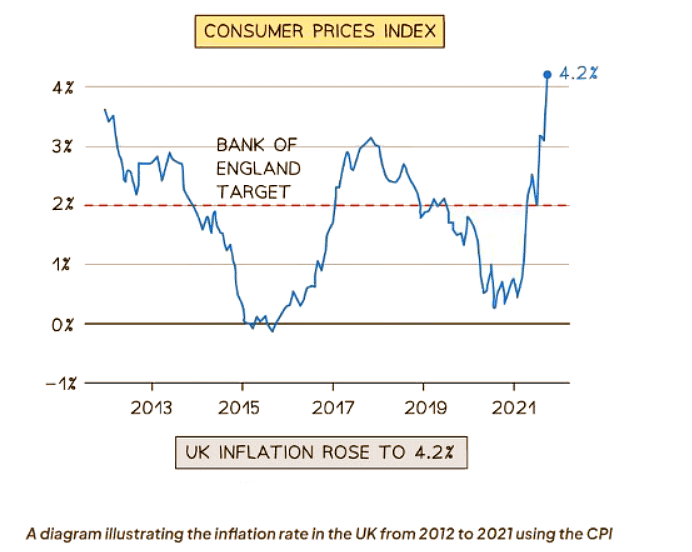Class 10 Exam > Class 10 Notes > Economics for GCSE/IGCSE > The Five Macroeconomic Aims
The Five Macroeconomic Aims | Economics for GCSE/IGCSE - Class 10 PDF Download
| Table of contents |

|
| Economic Growth |

|
| Low Unemployment |

|
| Low & Stable Rate of Inflation |

|
| Balance of Payments Stability On The Current Account |

|
| The Redistribution of Income |

|
Economic Growth
- Economic growth stands as a primary macroeconomic objective for most governments.
- Numerous developed countries aim for an annual growth rate of 2-3%, viewed as sustainable and less likely to trigger excessive demand-pull inflation.
- Political leaders frequently use it as a measure of the success of their policies and leadership.
- Economic growth yields beneficial effects on confidence levels, consumer spending, investment levels, job creation, income levels, living standards, and government finances.

A Table Highlighting Some of the Economic Growth Trends in the UK Since 1998
Low Unemployment
- When someone is without a job and actively seeking employment, they are classified as unemployed.
- The ideal unemployment rate varies based on the size of the economy. For instance, India may consider 6.5% acceptable, while Singapore targets a rate below 2%.
- An economy is deemed more efficient when it nears full employment, indicating optimal utilization of its workforce.
- Unemployment metrics reflect a focus on specific demographic segments, such as youth or ethnic/racial groups. For example, in 2021, Black unemployment in the USA stood at 8.7%, while White unemployment was at 4.7%.

- Unemployment and real Gross Domestic Product (GDP) share an inverse relationship.
- When the real GDP of a country grows, unemployment rates tend to fall. Conversely, during periods of real GDP decline, unemployment rates typically rise.
- Following the global financial crisis of 2007, the UK experienced a prolonged period of relatively high unemployment rates.
Low & Stable Rate of Inflation
- Most economies aim for a modest inflation rate around 2% measured by the Consumer Price Index (CPI)
- A low inflation rate is indicative of a healthy economy in terms of growth
- Inflation can stem from different sources like cost-push or demand-pull factors, each requiring distinct government interventions:
- Policies addressing demand-pull inflation focus on managing overall demand in the economy
- Policies tackling cost-push inflation concentrate on reducing production costs

- In the UK, a consistent deviation from the 2% target is considered unstable.
- An inflation rate ranging from 4-5% in April 2022 was viewed as unstable, leading to a decline in household purchasing power.
- Maintaining a low and steady inflation rate is crucial as it:
- Enables firms to make confident decisions for future investments.
- Provides price stability for consumers.
Balance of Payments Stability On The Current Account
- The Balance of Payments (BoP) of a nation documents all financial dealings between the country and the rest of the world.
- The Current Account primarily focuses on the financial transactions concerning the trade of goods and services.
- Governments strive for equilibrium in the Balance of Payments on the Current Account, where exports match imports.
- If exports surpass imports, it leads to a surplus in the current account; conversely, if imports exceed exports, it results in a deficit.
- Each scenario carries its own set of advantages and drawbacks, yet a current account deficit poses more challenges in the long term.
- Traditionally, the UK has maintained a slight deficit in its current account, yet as a percentage of GDP, this deficit has been negligible and not problematic.

- The trade deficit in the UK has been decreasing steadily since 2016.
- During this period, the value of exports has been increasing at a slightly faster rate compared to the value of imports.
Question for The Five Macroeconomic AimsTry yourself: What is a primary macroeconomic objective for most governments?View Solution
The Redistribution of Income
- Income redistribution endeavors to mitigate income inequality within an economy.
- Heightened income inequality can instigate social unrest and potentially lead to revolutions.
- However, absolute income equality is not desirable as it diminishes incentives for work and education.
- Governments seek to redistribute income through taxing the affluent and offering welfare assistance to the impoverished.
- Unregulated capitalism tends to result in significant income inequality.
- The affluent can consistently procure factors of production, consolidating ownership among fewer individuals who amass the majority of the world's wealth.
- Government intervention is necessary to sustain acceptable levels of income inequality.
- While absolute poverty is typically more severe in developing nations, even in advanced economies like Germany, a mere 1% increase in income inequality can significantly exacerbate relative poverty among households.
The document The Five Macroeconomic Aims | Economics for GCSE/IGCSE - Class 10 is a part of the Class 10 Course Economics for GCSE/IGCSE.
All you need of Class 10 at this link: Class 10
|
56 videos|97 docs|38 tests
|
FAQs on The Five Macroeconomic Aims - Economics for GCSE/IGCSE - Class 10
| 1. What is economic growth and why is it important for a country's economy? |  |
Ans. Economic growth refers to an increase in a country's output of goods and services over time. It is important for a country's economy as it leads to higher levels of income, employment, and overall well-being for its citizens.
| 2. How does low unemployment benefit an economy? |  |
Ans. Low unemployment benefits an economy by ensuring that more people are able to contribute to the workforce, leading to increased production and economic growth. It also reduces government spending on social welfare programs and boosts consumer spending.
| 3. Why is a low and stable rate of inflation desirable for an economy? |  |
Ans. A low and stable rate of inflation is desirable for an economy as it helps maintain the purchasing power of the currency, encourages investment, and promotes economic stability. It also reduces uncertainty for businesses and consumers.
| 4. What is balance of payments stability on the current account and why is it important? |  |
Ans. Balance of payments stability on the current account refers to a situation where a country's exports and imports are in balance. It is important as it indicates that a country is able to pay for its imports with its exports, which helps maintain a stable exchange rate and overall economic stability.
| 5. How does the redistribution of income contribute to a more equitable society? |  |
Ans. The redistribution of income involves policies that aim to reduce income inequality by transferring wealth from higher-income individuals to lower-income individuals. This helps create a more equitable society by ensuring that all members have access to basic necessities and opportunities for economic advancement.
Related Searches




















